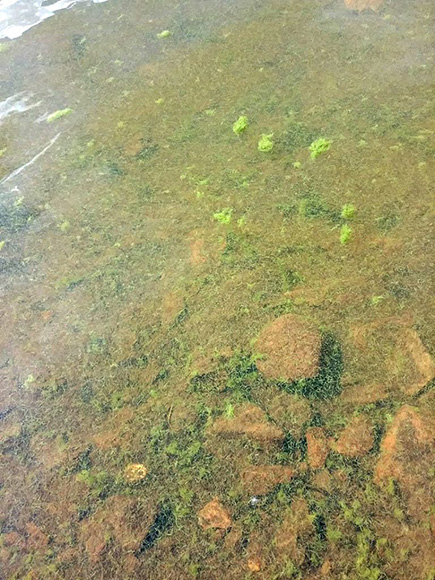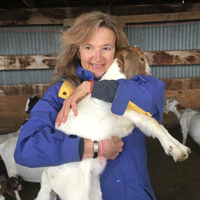
By Christine Osborne
A hot summer day, a cool swim in a lake with your canine companion … what could be better? Unfortunately, as several dog owners learned last week, that perfect summer outing can turn deadly quickly if the lake or pond contains toxins from a harmful algal bloom. While there are no confirmed reports of dog fatalities in Utah this summer, dogs in Texas, Georgia, and North Carolina died recently after exposure to toxins in lakes and ponds.
Dogs are particularly susceptible to the effects of harmful algal blooms (HABs). Many pet owners are unaware of the dangers of harmful blooms or even how to spot one.

What Are Harmful Algal Blooms (HABs)?
HABs aren’t actually caused by algae. They are actually caused by cyanobacteria, naturally occurring organisms that can photosynthesize like plants. Cyanobacteria are present in most waterbodies and are generally beneficial. Blooms occur when excess nutrients such as nitrogen and phosphorus enter waterways and cause their populations to explode.
What Do HABs Look Like?
Blooms can look like pea soup, spilled paint, or water that has a green or blue-green hue. They often form floating scums or mats that accumulate along shorelines. Many harmful blooms in Utah resemble grass clippings or small nodules floating in the water. Visit DEQ’s photo gallery on its HABs webpage to find pictures of Utah blooms.
How Can You Tell if There Are Toxins?
You can’t tell whether a waterbody contains toxins just by looking at it. Lab test results from water samples are the only way to know for sure if toxins are present and at what levels. Toxins are usually released when the cyanobacteria die off or are broken apart in a process known as lysing. Dogs can accidentally lyse these cells by chewing on algal mats or scum, which releases the toxins immediately into their systems. If you are unsure whether it’s safe for your pet to be in or near the water, follow the old adage: when in doubt, keep out.

What Are the Signs of Exposure?
Cyanobacteria produce three kinds of toxins: liver toxins (hepatotoxins), nerve toxins (neurotoxins) and skin (dermal) toxins. The onset of symptoms can range from minutes to hours after exposure. If you suspect exposure, seek immediate care from your veterinarian. These toxins are fast-acting, and there is no known cure. Even with proper veterinary care, most exposures are fatal. Prevention is the best way to protect your dog.
Signs of cyanotoxin poisoning include:
- Repeated vomiting (usually green liquid)
- Diarrhea or dark, bloody stool
- Loss of appetite
- Dark urine or reduced/ no urine output
- Stumbling
- Seizures, convulsions, and/or paralysis
- Excessive salivation/drooling
- Disorientation or inactivity
- Difficulty breathing
How Can I Keep My Dog Safe?
- Don’t let dogs wade, drink the water or eat/walk in beach debris.
- Keep your dog on a leash near shorelines.
- If your dog goes in the water, remove him or her immediately.
- Don’t let them lick their fur or paws after getting out of the water.
- Rinse and wash them thoroughly with clean water and use a towel or rag to remove algal debris.
Before you head out to your favorite lake or reservoir, visit the DEQ HABs page to see if your destination is under a health advisory for cyanobacteria. DEQ posts HABs lab results as soon as they are received, but conditions can change quickly on any waterbody. Be mindful of current conditions and avoid areas that appear to be experiencing a bloom. Since DEQ isn’t able to sample every lake or pond in the state, it’s important for you to use your judgment before letting your dog frolic in his or her favorite swimming hole.
The scientists at DEQ want you and your pet to have a fun, HAB-free summer. Use these tips and resources to keep you and your furry family members safe when recreating in Utah’s waters.
Visit DEQ’s website for more information on how to protect your dog from harmful algal blooms. Obey all posted health advisories — they are issued when lab confirmation shows toxin or cyanobacteria levels above health thresholds. If you observe a possible HAB, please notify the 24-hour DEQ Spill Line at 801-536-4123. If you believe your dog has been exposed to a HAB, please call the Utah Poison Control Center (UPCC) at 1-800-222-1222 even if you visit your veterinarian. UPCC keeps data on animal exposure, and this information helps DEQ and the Utah Department of Health monitor exposures and their locations.

I am a content strategist/communication specialist at the Utah Department of Environmental Quality. I have a Masters in Strategic Communication (MSC) degree from Westminster College and earned my Accreditation in Public Relations (APR) from the Public Relations Society of America (PRSA). I currently teach Integrated Marketing Communication to graduate students in the MSC program at Westminster. In a previous life, I was a bassoonist with the Utah Symphony for 26 years. I love to hike, bike, camp, read, garden, geek out on all things science, and spend time with two college-age sons. I volunteer with a number of local refugee organizations and am currently a teen mentor with the 4-H New American Goat Club and Teen Leadership Club.

